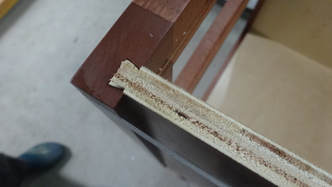VINA CABINETRY
 Dovetail face framed kitchen cabinets Dovetail face framed kitchen cabinets Sliding dovetails provide several advantages over a dado joint. First, they're stronger because they don't rely solely on glue. Second, the shoulders of the dovetailed piece hide the edges of the slot, much as a tenoned workpiece hides a mortise. And the exposed dovetail provides a visible signature of your craftsmanship. Cabinet Sourcing is proud to make high quality sliding dovetail face framed kitchen cabinets. Also we can make similar construction where top and bottom connect to sides. This construction save our customers assembly time and make it easier. To make this joint, you'll rout the dovetail slot first, then cut and size the dovetail to fit. For the slot you'll need a handheld router and the dado jig shown below. In addition to a 5⁄8 " guide bushing, you'll need a 1⁄4 " spiral downcut bit for clean cuts (a 1⁄4 " straight bit will also work) and a 1⁄2 " dovetail bit. We chose a 7° dovetail bit because it leaves a thicker, stronger "neck" on the dovetail than a 14° bit would. You will shape the dovetail on a router table. For testing the router-table setup, prepare a panel the same thickness and about the same width as the project panels to be dovetailed. You will cut the dovetail slot in two operations. First, to reduce the load on the dovetail bit, remove most of the waste with the spiral downcut bit. Then switch to the dovetail bit to complete shaping the slot. Because the dovetail slot tapers from bottom to top, the inside edges of the jig do not align with the top edges of the slot, photo below. To reposition the jig accurately for each operation, use the jig to draw layout lines on your workpieces to define both sides of the slots. Install the bushing and spiral downcut bit, and set the bit's cutting depth to 1⁄16 " less than the final depth of the slot. Clamp the jig along the layout lines and rout across the panel. Rout each slot with this setup. Comments are closed.
|
Archives
May 2024
Categories |


 RSS Feed
RSS Feed
